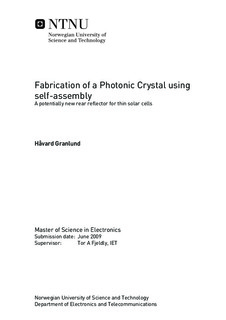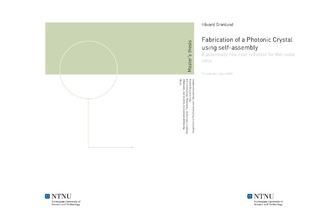| dc.description.abstract | The major issue with solar cells today, is the price per watt. To tackle this challenge several approaches are being made. One possible approach is to reduce the amount of silicon raw material used in todays wafer-based solar cells by making the wafers thinner. This approach does however bring with it another problem; much of the incident light will escape the cell before being absorbed. One possible way to solve this problem is to use a photonic crystal (PC) as a rear reflector. PCs is a periodic dielectric structure that can reflect light in a non-specular manner, which can substantially increase the optical pathlength for the light within the cell, and hence increase the probability of absorption- One such PC is the inverted opal. To make an inverted opal, one first fabricates a synthetic opal, consisting of microspheres of some kind, that can be used as a template. The gaps between the spheres of such an opal can then be filled with a suitable dielectric, e.g. silicon, and the spheres can be removed by a selective process, leaving the inverted opal structure. In this master project, opals were attempted made with Ugelstad spheres and polysterene (PS) spheres. With the Ugelstad spheres, wafer sized monolayers were made, but opals were not achieved. The PS spheres however, proved very suitable, and opals with a grain size of 150x300$mu m$ were successfully made. These opals were then partially inverted, by first filling in the gaps between the spheres with silicon, using a low temperature low pressure PECVD process, and then heating the samples to 600 degrees Celsius for 2.5 hours. | nb_NO |

